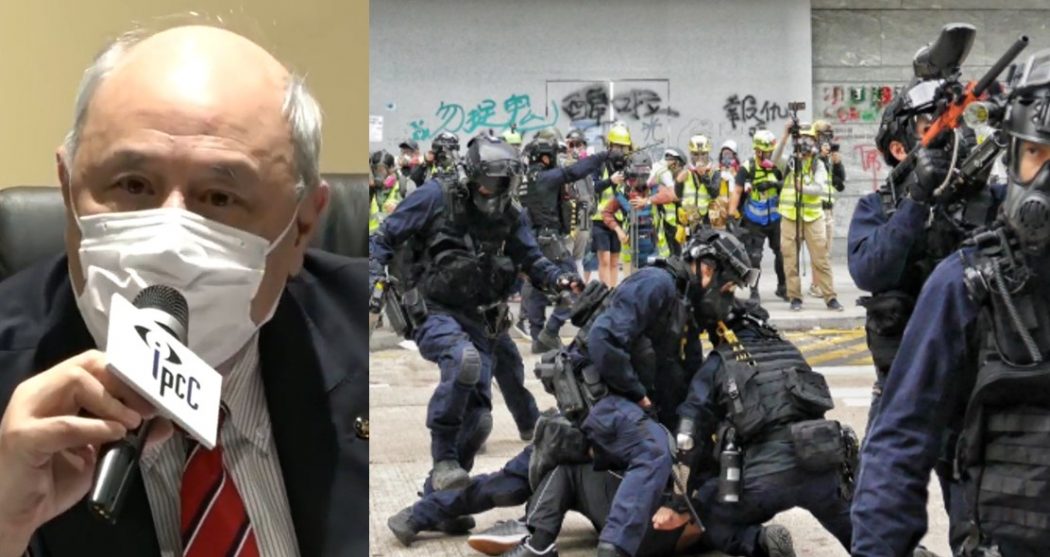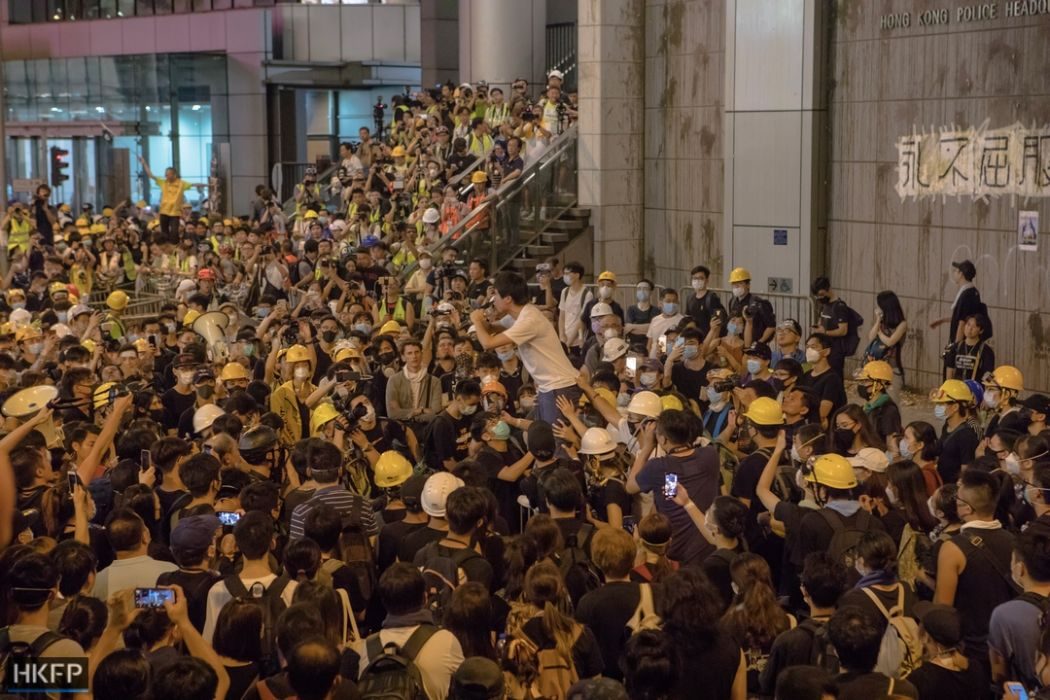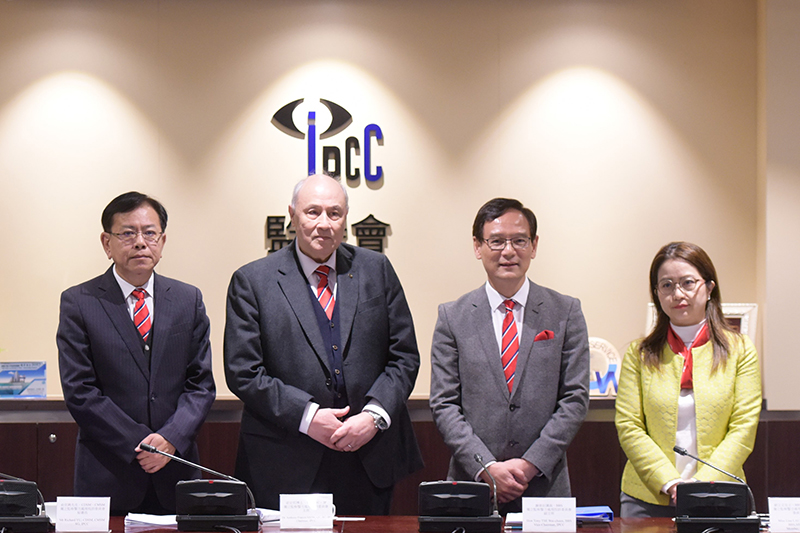By Tom Grundy, Jennifer Creery, Kelly Ho and Rachel Wong.
Hong Kong ‘s Independent Police Complaints Council (IPCC) has released its 999-page report on the behaviour of the police force during last year’s city-wide protests and unrest, concluding that officers generally acted within guidelines but there was “room for improvement.”

The watchdog – which received 1,755 complaints – examined demonstrations and incidents which took place between June 9, 2019 and March 2020. The report included closer studies of six key events, including the Yuen Long mob attack last July where protesters and MTR passengers were targetted by white-clad men wielding sticks.
Police faced criticism for being absent during much of the incident, with protesters accusing the force of colluding with triad gangs. The IPCC found that there were “deficiencies in Police deployment and other Police action in response to the events,” however it said it found no evidence of collusion with criminals “despite our best efforts in searching publicly available sources.”
It echoed the police in stating that it had failed to communicate effectively about its actions and deployment on the night in question.

Protests erupted last June over a now-axed extradition bill. They escalated into sometimes violent displays of dissent against police behaviour, amid calls for democracy and anger over Beijing’s encroachment.
The report concluded that the reputation of the force had been damaged during the unrest: “The image of the Police has lost its lustre and the city of Hong Kong has lost its hard-earned reputation as a peaceful city. Most disheartening, too, is the psychological trauma the violence has wrought, particularly on the minds of young people.”
However, it also raised concerns about increasing protest violence: “From recent seizures of assault rifles, handguns and ammunition, and materials for bomb-making, it seems that our community is being dragged into an era of terrorism. It is the duty of the Police Force to keep the peace and maintain law and order, in protection of all. Under the violence they had to face in performance of their duty, the Police had found it necessary to resort on occasions to the use of force.”

The IPCC also echoed the force is claiming that the internet had become an “effective tool to spread hate messages with little or no basis,” targetted at the police. Many such cases amounted to “blatant propaganda with little or no factual basis, aimed at smearing the Police Force and impeding police officers from performing their duty to maintain law and order,” it said.
2019 protest incidents
- ‘Million-man’ march: During a June 9 anti-extradition law protest, which organisers said was attended by a million people, the IPCC said that police were not pro-active in their use of force. However, it said that officers had reacted in the face of violence by some protesters, adding that the force had learned some lessons. It “subsequently adopted a proactive and flexible approach” in managing future processions on June 16 and July 1.
- June 12 unrest: Protesters fled into Citic Tower in Admiralty last June after police fired tear gas, but the IPCC refrained from commenting: “The IPCC will not make any judgement whether the Police action in this incident was proper or not due to ongoing judicial review proceedings concerning this Incident.”
- Protesters break into legislature: Regarding the police reaction to protesters breaking into the legislature last July 1, the report said the force had failed to secure the premises: “Had the Police taken precautions to contain and protect the LegCo Complex, such as setting up stronger barriers, the protesters breaking in and vandalising might well have been avoided.”

- MTR tear gas: Last year, police released tear gas in Kwai Fong metro station and projectiles within the confines of Tai Koo MTR. “In the incident in Tai Koo Station, the pepper ball rounds should not have been aimed at or hit protesters above the shoulder,” the report concluded. It added that police guidelines permit the use of tear gas when necessary, but it recommended the force review its guidelines to provide clearer instructions to officers.
- Prince Edward MTR incident: Last August 31, baton-wielding police faced criticism after storming Prince Edward MTR station, deploying pepper-spray and making arrests. Better communication was needed between police and fire services, the report said, amid multiple injuries on the platform. Despite rumours circulating among protesters, it said there was “no evidence whatsoever” of any deaths.
Regarding last year’s 12 live-fire incidents, the IPCC said that no officers had contravened guidelines in their use of live bullets.
Delays and controversy
Demonstrators have long-demanded an independent probe into the police conduct, but the IPCC does not have investigative powers and cannot summon witnesses.

The watchdog is usually tasked with reviewing the work of the Complaints Against Police Office, an internal police department.
Friday’s report has been delayed by legal action and, last December, a group of five international experts hired to advise the body said they would “formally stand aside.” They cited a crucial shortfall “in the powers, capacity and independent investigative capability” of the watchdog.
Rights NGO Amnesty International said in March that the current complaints system lacked investigative power and impartiality, falling below international standards. It said last year that police had used reckless tactics and retaliatory violence in their crackdown on protesters, resulting in injuries such as broken bones and internal bleeding.
‘International standards’
The IPCC report concluded that the “extensive guidelines for the use of force are by and large on par with international guidelines but there are areas for improvement.”
It recommended that the police enhance their guidelines on the use of tear gas in densely populated urban settings and set up a committee comprising of medical and scientific experts to ensure tear gas and pepper spray are within acceptable toxicological limits.

“The report is not about cases of personal excessive use of force or individual misconduct,” said IPCC chair Anthony Neoh. “We have another mechanism for that. The report is a broad picture that takes a look at the shortcomings and suggests on how to improve.”
The report also recommended the police should better assess risks on site, and communicate in a more effective and timely manner to restore public trust. It said the force should coordinate with the media and legal advisers, and recognise the power of the Internet.
21 officers ‘reprimanded’
The force said that, as of February, they had fired a total of 19 live rounds, 16,191 tear gas rounds, 10,100 rubber bullets, 1,880 react rounds, 2,033 bean bag rounds and 1,491 bottles of pepper spray when handling large-scale disorder related to the protests. They made over 8,000 arrests.

Police chief Chris Tang told the media in March that 21 police officers had been “reprimanded” over their conduct during the protests including an officer who drove his motorcycle into protesters last November.
Chief Executive Carrie Lam is set to meet the press at 6pm.

